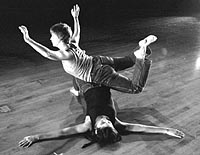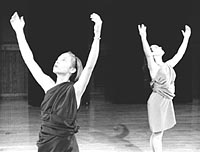

Modern dance is an art form that is intensely personal. This personal nature sets up an interesting dilemma: how does a choreographer display these complex emotions and ideas clearly without creating a work that is mired in subjectivity and introspection?
When the balance between the personal and the accessible is right, modern dance can be thrilling; the best dance can be cathartic. Fall Forward, Oberlin's fall dance performance, gave student choreographers the opportunity to grapple with this issue.

Due to their level of experience, the student choreographers have a hard time translating their feelings into clear, unified statements. Parts of works are much better than entire works; the personal encroaches on the accessible.
Fall Forward opened with senior Steffany Haaz's gymnastic and highly energetic "Broken Table." The most focused of the seven works, Haaz's piece constantly juxtaposes the idea of loss of control with that of overcoming fear. Performed to silence, Haaz used every angle the uneven table afforded her.
Pitched at a slant, the table seemed to be both Haaz's dance partner and oppressor. In the beginning of the piece, the table acted as a cage, confining and containing her. By gripping the metal legs and twisting her fist, Haaz made the table groan and creak, emitting sounds eerily reminiscent of human suffering.
Vaulting out of her confinement, Haaz nimbly maneuvered onto the top of her oppressor. She used the angle of the table as if it werea cliff, having to decide between staying on top and letting go. For this short instant, Haaz looked like the figurehead of a ship that was slowly sinking, an image that revealed both compassion and defeat.
The next piece, sophomore Jason G. Corff's "Dare," felt muddled. Though containing wonderful movement, the piece was missing something. Perhaps Corff wanted to address a larger issue, but he never committed to one.
Entering bare-chested in billowing, harem-style pants, to the strains of Celtic singer Loreena McKennitt's Indian inspired song "Marco Polo," Corff and partner sophomore Eric Lamb left no doubt as to their technical skills.

Their movements were fluid and bold, with both dancers vacillating between separateness and unity, as lights flashed from white to red. This issue needed to be addressed in greater detail.
Corff being white and Lamb being African-American, the obvious issue that Corff may have been trying to address was that of race. Corff has Lamb strike some mothering poses, which leads the viewer to believe that the piece might be about family.
Does the "dare" of the title refer to any of these issues? The answer is never made clear. The dancing itself is always interesting though, and Corff should be commended for his cultural experimentation.
Juliana F. May's "Pedestrian Crossing," with music by Philip Glass, had the most imaginative details of all the pieces. This piece exemplified the problem that many of the pieces contained: fascinating stylistic features, yet the whole doesn't quite mesh together.
May's six dancers wiped their noses, pulled their necks as if to rid their throats of something, and wiped their eyes. Done in succession, these movements added a childlike and innocent dimension to the piece.
Fall on me: Alexis Macnab and Jessie Marshall. (photo by Noah Mewborn)
Fall Forward: Performers senior Jeremy Kucholtz, senior Ana Marioa Alvarez, junior Ariane Jay, senior Alyce Caitlin Medlock, and senior Chwee Sze Foong. (photo by Noah Mewborn)
Copyright © 1998, The Oberlin Review.
Volume 127, Number 8, November 6, 1998
Contact us with your comments and suggestions.